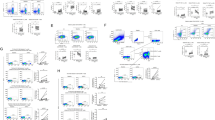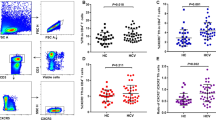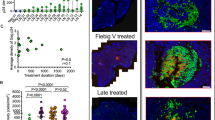Abstract
The mechanisms responsible for the persistence of HIV-1 after many years of suppressive antiretroviral therapy (ART) have been only partially elucidated. Most of the studies investigating HIV-1 persistence have been performed with blood, although it is well known that germinal centers (GCs) within lymph nodes (LNs) serve as primary sites for HIV-1 replication. We sought to identify the memory CD4 T cell populations in blood and LNs that are responsible for the production of replication-competent and infectious HIV-1, as well as for active and persistent virus transcription in ART-treated (for 1.5–14.0 years), aviremic (<50 HIV RNA copies/ml) HIV-infected individuals. We demonstrate that LN CD4 T cells that express programmed cell death 1 (PDCD1; also known as PD-1), which are composed of about 65% T follicular helper cells as defined by the expression of the cell surface receptors CXCR5 and PD-1, are the major source of replication-competent HIV-1 and of infectious virus, as compared to any other (CXCR5−PD-1− and CXCR5+PD-1−) blood or LN memory CD4 T cell populations. LN PD-1+ cells accounted for 46% and 96% of the total pools of memory CD4 T cells containing inducible replication-competent or infectious virus, respectively. Notably, higher levels of cell-associated HIV-1 RNA were present in LN PD-1+ cells after long-term (up to 12 years) ART than in other memory CD4 T cell subpopulations. These results indicate that LN PD-1+ cells are the major CD4 T cell compartment in the blood and LNs for the production of replication-competent and infectious HIV-1, and for active and persistent virus transcription in long-term-ART-treated aviremic individuals. Thus, these cells may represent a major obstacle to finding a functional cure for HIV-1 infection.
This is a preview of subscription content, access via your institution
Access options
Subscribe to this journal
Receive 12 print issues and online access
$209.00 per year
only $17.42 per issue
Buy this article
- Purchase on Springer Link
- Instant access to full article PDF
Prices may be subject to local taxes which are calculated during checkout





Similar content being viewed by others
References
Chun, T.W. et al. Presence of an inducible HIV-1 latent reservoir during highly active antiretroviral therapy. Proc. Natl. Acad. Sci. USA 94, 13193–13197 (1997).
Chun, T.W. et al. Quantification of latent tissue reservoirs and total body viral load in HIV-1 infection. Nature 387, 183–188 (1997).
Finzi, D. et al. Identification of a reservoir for HIV-1 in patients on highly active antiretroviral therapy. Science 278, 1295–1300 (1997).
Wong, J.K. et al. Recovery of replication-competent HIV despite prolonged suppression of plasma viremia. Science 278, 1291–1295 (1997).
Siliciano, J.D. et al. Long-term follow-up studies confirm the stability of the latent reservoir for HIV-1 in resting CD4+ T cells. Nat. Med. 9, 727–728 (2003).
Chomont, N. et al. HIV reservoir size and persistence are driven by T cell survival and homeostatic proliferation. Nat. Med. 15, 893–900 (2009).
Buzon, M.J. et al. HIV-1 persistence in CD4+ T cells with stem-cell-like properties. Nat. Med. 20, 139–142 (2014).
Kim, C.H. et al. Subspecialization of CXCR5+ T cells: B helper activity is focused in a germinal-center-localized subset of CXCR5+ T cells. J. Exp. Med. 193, 1373–1381 (2001).
Breitfeld, D. et al. Follicular B helper T cells express CXC chemokine receptor 5, localize to B cell follicles and support immunoglobulin production. J. Exp. Med. 192, 1545–1552 (2000).
Schaerli, P. et al. CXC chemokine receptor 5 expression defines follicular homing T cells with B cell helper function. J. Exp. Med. 192, 1553–1562 (2000).
Perreau, M. et al. Follicular helper T cells serve as the major CD4 T cell compartment for HIV-1 infection, replication and production. J. Exp. Med. 210, 143–156 (2013).
Fukazawa, Y. et al. B cell follicle sanctuary permits persistent productive simian immunodeficiency virus infection in elite controllers. Nat. Med. 21, 132–139 (2015).
Fletcher, C.V. et al. Persistent HIV-1 replication is associated with lower antiretroviral drug concentrations in lymphatic tissues. Proc. Natl. Acad. Sci. USA 111, 2307–2312 (2014).
Casazza, J.P.I. et al. Identification and characterization of individual HIV-infected CD4 T cells ex vivo. (Conference on Retroviruses and Opportunistic Infections, Seattle, abstract no. 49) (International Antiviral Society–USA, San Francisco, California, USA, 2015).
Locci, M. et al. Human circulating PD-1+CXCR3−CXCR5+ memory TFH cells are highly functional and correlate with broadly neutralizing HIV antibody responses. Immunity 39, 758–769 (2013).
Morita, R. et al. Human blood CXCR5+CD4+ T cells are counterparts of T follicular cells and contain specific subsets that differentially support antibody secretion. Immunity 34, 108–121 (2011).
Banga, R., Procopio, F.A., Cavassini, M. & Perreau, M. In vitro reactivation of replication-competent and infectious HIV-1 by histone deacetylase inhibitors. J. Virol. 90, 1858–1871 (2015).
Hu, Y. & Smyth, G.K. ELDA: extreme limiting dilution analysis for comparing depleted and enriched populations in stem cell and other assays. J. Immunol. Methods 347, 70–78 (2009).
Sobolewski, M.C.A., Lalama, C., Bosch, R. & Mellors, J. A rapid virion-recovery assay reveals a larger population of inducible proviruses in resting CD4+ T cells than previously recognized. (Conference on Retroviruses and Opportunistic Infections, Atlanta, abstract no. 174LB) (International Antiviral Society–USA, San Francisco, California, USA, 2013).
Bullen, C.K., Laird, G.M., Durand, C.M., Siliciano, J.D. & Siliciano, R.F. New ex vivo approaches distinguish effective and ineffective single agents for reversing HIV-1 latency in vivo. Nat. Med. 20, 425–429 (2014).
Ganusov, V.V. & De Boer, R.J. Do most lymphocytes in humans really reside in the gut? Trends Immunol. 28, 514–518 (2007).
Procopio, F.A. et al. A novel assay to measure the magnitude of the inducible viral reservoir in HIV-infected individuals. EBioMedicine 2, 872–881 (2015).
Vandergeeten, C. et al. Cross-clade ultrasensitive PCR-based assays to measure HIV persistence in large-cohort studies. J. Virol. 88, 12385–12396 (2014).
Lorenzo-Redondo, R. et al. Persistent HIV-1 replication maintains the tissue reservoir during therapy. Nature 530, 51–56 (2016).
Altman, D.G. Practical Statistics for Medical Research (CRC Press, 1991).
Yukl, S.A. et al. The distribution of HIV DNA and RNA in cell subsets differs in gut and blood of HIV-positive patients on ART: implications for viral persistence. J. Infect. Dis. 208, 1212–1220 (2013).
Perreau, M. & Kremer, E.J. Frequency, proliferation and activation of human memory T cells induced by a nonhuman adenovirus. J. Virol. 79, 14595–14605 (2005).
Pantaleo, G. et al. Lymphoid organs function as major reservoirs for human immunodeficiency virus. Proc. Natl. Acad. Sci. USA 88, 9838–9842 (1991).
Vandergeeten, C. et al. Interleukin-7 promotes HIV persistence during antiretroviral therapy. Blood 121, 4321–4329 (2013).
Acknowledgements
We are grateful to N. Grandchamp, P. Pochon, X. Bron, M. Graff, A. Crétignier, R. Mamin, F. Bellanger, L. Leuenberger and C. André for technical assistance, and to D. Alves and the study manager N. Rettby. This work was funded by an educational grant from Bristol-Myers Squibb (M.P.).
Author information
Authors and Affiliations
Contributions
R.B., F.A.P. and A.N. performed the experiments; G. Pollakis performed and analyzed HIV sequencing; M.C. recruited patients; K.O. performed statistical analyses; J.-M.C. performed lymph node biopsies; L.d.L. was in charge of immunohistochemistry experiments; G. Pantaleo and M.P. conceived the study, designed the experiments and wrote the manuscript.
Corresponding authors
Ethics declarations
Competing interests
The authors declare no competing financial interests.
Supplementary information
Supplementary Text and Figures
Supplementary Figures 1–5 (PDF 2145 kb)
Rights and permissions
About this article
Cite this article
Banga, R., Procopio, F., Noto, A. et al. PD-1+ and follicular helper T cells are responsible for persistent HIV-1 transcription in treated aviremic individuals. Nat Med 22, 754–761 (2016). https://doi.org/10.1038/nm.4113
Received:
Accepted:
Published:
Issue Date:
DOI: https://doi.org/10.1038/nm.4113
This article is cited by
-
Phenotypic characterization of single CD4+ T cells harboring genetically intact and inducible HIV genomes
Nature Communications (2023)
-
Therapeutic vaccination following early antiretroviral therapy elicits highly functional T cell responses against conserved HIV-1 regions
Scientific Reports (2023)
-
Molecular mechanisms by which the HIV-1 latent reservoir is established and therapeutic strategies for its elimination
Archives of Virology (2023)
-
HIV silencing and cell survival signatures in infected T cell reservoirs
Nature (2023)
-
NK cell spatial dynamics and IgA responses in gut-associated lymphoid tissues during SIV infections
Communications Biology (2022)



